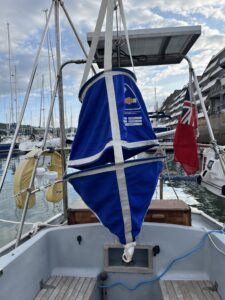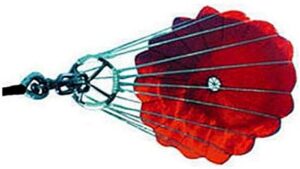I’ve now had three people write and thank me for a single reference in Old Man Sailing.
I never thought it was anything special when I wrote it, sitting at anchor in St Helen’s Pool in the Scilly Isles. Certainly, there was no thunderclap as the words crawled across the screen. But it does seem to have struck a chord, so if you missed it, here it is from page 126:
“It is a great comfort to be stupid. Disasters about to happen do not trouble the minds of those too dim to imagine them.”
I have been thinking about this as I sit at anchor in the bay at Tazacorte on the Canary Island of La Palma waiting for the house sale to go through back in England so I can push off to the Caribbean.
Because, the other day, I did something that was incredibly stupid. Well, it seems like it to me. You be the judge, for here is the whole sorry story:
I had pulled into the marina at Santa Cruz on the other side of the island where there is a fabulous old Spanish colonial town but also incessant noise from the ferries and the cruise ships unloading the tourists who come to see it. But at least I could top up with diesel.
And then, being a conscientious engineer, I added the diesel bug treatment – 10ml for 20litres. Tucked in the cockpit locker next to it was a bottle of something called Diesel Blast (at least, I think that was what it was called, the label came off long ago). In fact, I hadn’t seen it for years. Apparently, when everything got turned upside down in the knockdown on the way from Falmouth, the Diesel Blast got thrown to the top of the heap – thus swapping places with the galley scissors which I haven’t seen since.
There wasn’t much left in the bottle. Did this sort of stuff go off? Might as well use it up. I squirted 15ml up into the measuring chamber at the top of the bottle.
And that’s when I saw the slug. Well, that’s what it looked like – a drowned slug. On the small size as slugs go but very large for a lump of diesel bug which was probably more likely. Anyway, you wouldn’t want either of them in your tank, would you?
I’m very particular about what goes into my tank. When I took on a deck cargo of 50litres of diesel from the dodgy-looking filling station in Banjul so that I could motor the 100 miles up the Gambia River to Baboon Island and back, I put every drop of it through a 5micron filter.
But not the slug.
The slug, I reasoned, would end up in the engine’s pre-filter anyway. I mean, something that size isn’t going to get through the pre-filter is it? Even if it did, what chance has it got with the main filter?
Well none, now I come to think about it. Because it’s going to get stuck in the pipe before it gets to the filter, isn’t it?
And what will happen then?
The engine will stop.
I’m not very happy about the idea of the engine stopping – haven’t been since last summer coming into Portland Harbour.
This was during one of my incessant trips up and down the English Channel. What with Amsterdam for the Aries, Beaulieu for the OCC rally, Newort IOW for the watermaker (twice), Cowes for the Royal Yacht Squadron book club, Liverpool for university graduation, Dublin for the weather and lunch with Jim Gallagher, the family in Jersey – and Falmouth, of course, at every opportunity because it is, well, Falmouth after all … I really can’t remember when it was that I went into Portland Harbour.
But I do remember there was a gale coming. I had it all worked out. I could get there just before the gale arrived.
I was on time. It was the gale that was early.
Of course, I could have sheltered in Weymouth Bay – anchored just off the beach. I’ve done that before. There’s good holding in sand – but, of course, Weymouth sand is famously fine (hence the annual sand sculpture festival) and while my new Spade anchor has glowing reviews from all the experts, it is physically smaller than the Rocna and might therefore, not be quite as secure in soft mud or fine sand.
Maybe I would sleep better in Portland Harbour. I’d never been to Portland Harbour. Why I thought this was a good reason for going there, I have no idea – especially as the wind had now climbed over 30kts and I couldn’t take in the second reef because there were a couple of navy ships at anchor to leeward. Instead, I started the engine to give the boat a bit of a lift for the last mile to the entrance.
In fact, what with too much sail up, too much heel and, consequently too much leeway, by the time we reached the entrance, the little 21hp Nanni was the only thing that was keeping us going.
And it continued to be the only thing keeping us going as we passed (agonisingly slowly) through the north entrance with the great granite boulders of the breakwater two boat’s lengths under our lee.
I remember thinking to myself that if the engine were to stop now, I wouldn’t be able to tack. We’d just sail sideways into the harbour wall. There’s many a ship that’s sailed sideways into a harbour wall.
We didn’t of course. We just spent 40 minutes burning diesel and punching at about half a knot into what was now a full 40kts across the deck. By the time I tipped the anchor over the bow on the western side, I was thinking that really, Weymouth Bay had a lot going for it – sand sculptures or not…
So, you will understand why the slug has got to come out of the tank.
The official routine for doing this is to empty the tank, open the inspection hatch and get in there when a good supply of clean rags.
If you don’t have an inspection hatch and you’ve just filled the tank to the brim, you have to wait a bit and when there’s hardly any left, pump out what there is, pass it through the 5micron filter you should have used in the first place, pour it back, stir it round, pump it out again – and keep on doing that until it runs clear.
And you still don’t know whether the slug has been hiding in a corner the whole time and is just waiting for the right moment to reappear – like Portland Harbour in a gale…
Like I said: Stupid.




I wonder how quickly a slug will dissolve in diesel? Anybody got a slug and a jam jar?
Reminds me of the time I hurried out of Chatham dockyard only to loose engine in front of incoming Medway Queen. I had forgotten to turn on the fuel delivery to the engine. Tried to put on a good show,,,,but I think I failed to entertain MQs skipper.
had a similar issue with a piece of paper rag in the fuel tank, heaven knows when it got in there but eventually it found its way to the outlet, variably blocking it but never completely. Extracted using a Pela pump and some luck.
Oh Dear!!!!!!!!!!!!!!!
Just proves you are human after all …… carry on tee hee hee……